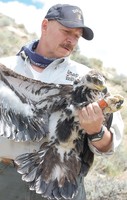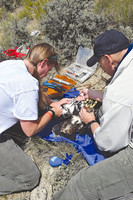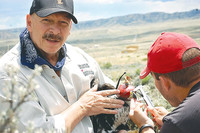Clear, 73° F
The golden eagle project director is Chuck Preston, senior curator of natural science and founding curator-in-charge of the Buffalo Bill Center of the West Draper Natural History Museum. Preston and his crew have been studying golden eagles in the …
This item is available in full to subscribers.
The Powell Tribune has expanded its online content. To continue reading, you will need to either log in to your subscriber account, or purchase a subscription.
If you are a current print subscriber, you can set up a free web account by clicking here.
If you already have a web account, but need to reset it, you can do so by clicking here.
If you would like to purchase a subscription click here.
Please log in to continue |
|





A team headquartered at the Draper Museum is studying golden eagles to learn how to manage and protect the raptors and their habitat.
The golden eagle project director is Chuck Preston, senior curator of natural science and founding curator-in-charge of the Buffalo Bill Center of the West Draper Natural History Museum. Preston and his crew have been studying golden eagles in the Big Horn Basin since 2009. On Friday, July 10, they were in Oregon Basin, just southeast of Cody.
Volunteer Richard Jones, principal pilot and consultant working on the long-term golden eagle project, was on belay as Nick Ciaravella, seasonal eagle research assistant, rapelled down the cliff to the nest perched on the stone.
It is easy to picture a chick the size of a fuzzy yellow Ping-Pong ball delighting children at Easter, but the only apparent similarity between a domestic chicken and golden eagle chick is the label designating their stage in life.
Like a periscope, the eagle chick extends its head over the rim of the nest of branches. The head itself is far bigger than a domestic chick.
The nest, No. 34, must be at least 3 feet across.
“This is actually one of the smaller ones,” said Nate Horton, research assistant working on the eagle project.
Ciaravella scales down the face to the left of the nest and then scrambles in. He places a cover over the bird’s head and eyes to reduce its stress, then gently places it in a tote bag. Ciaravella lowers the bag to Horton, who carries it to his waiting colleagues.
EXAM
Preston, Horton, Draper raptor program manager Melissa Hill and volunteer Kelsey Bean, a Bighorn National Forest seasonal employee, examine the young raptor.
They handle it carefully for the bird’s safety and their own. On its three toes are talons like obsidian scimitars. The chick’s belly still sprouts juvenile down, soft as peach fuzz. Its head is brown with streaks of white as though it’s been highlighted at a beauty parlor. Its beak looks powerful enough to rip the stone from the cliffs where it lives.
The researchers keep a hood on the bird during the examination to calm it, which the chick tolerates with minimal fuss.
While his team completes the exam, Preston cuddles the chick as though it’s an infant. “Shhh, shhh,” he says like a father comforting his baby at 3 a.m.
No parasites and no sign of disease have been found among the chicks examined this year, according to analyses performed by researchers at Boise State University in cooperation with the U.S. Fish and Wildlife Service Western Golden Eagle Team, Preston said.
The team draws 2 to 3 cubic centimeters of blood that will be sent to the University of Nevada, Reno, to test for lead and to ascertain the bird’s health. A mouth swab is taken as part of the check for disease, analyzed by Boise State University researchers in cooperation with the Golden Eagle Team. Boise State is specifically interested in avian trichomoniasis sometimes passed to raptors if they eat pigeons and doves. No sign of trichomoniasis has been detected in the project eagles, Preston said.
The chick weighs about about 8 pounds. “The wing span for that bird right now is a little over 6 feet,” Preston said.
An adult will have a wing span of 6.5-7 feet. Adult males weigh 8-10 pounds. Adult females reach 9-12 pounds. The biggest golden eagle caught in Wyoming was in the Bridger-Teton National Forest, weighing 16 pounds, Preston said.
Preston estimated the chick was 48 days old. About 80 percent of golden eagle chicks fledge by 51 days.
The chick also received leg bands from the U.S. Geological Survey (USGS) and one for Preston’s team.
The USGS bird banding lab band carries a unique number so that any bird in hand can be identified. “Our color bands, with a unique alphanumeric code, allow us to identify a bird from a distance using high-powered optics,” Preston said.
In a few minutes, the exam is complete. Horton carries the chick tote bag back up the hill, and Ciaravella pulls it back up to the nest with a rope. Then, Ciaravella leaves the nest to scale the cliff. The chick looks fine.
“Nice job, guys,” Preston tells his posse.
They checked the chick Monday. It continues to do well and has been exercising its wings in preparation for his first flight out of the nest, Preston said Wednesday.
GOLDEN COUNT
“We have identified and been monitoring 58 occupied nest territories this year,” Preston said. “An occupied nest territory is one where an adult pair is present, and in most cases have refurbished nests, and/or laid eggs.”
The team has visited seven nests and banded 16 birds this year. Typically, a nest will contain two eggs, but usually one chick survives. It is called sibling-cide; the older chick kills its younger/smaller sibling to procure all the food its parents bring to the nest, Preston said.
Three nests have produced three chicks each. “And that’s just phenomenal,” Preston said.
DIET
Around here, cottontail rabbits are golden eagles’ primary prey. It has been a good cottontail production year, and that ties directly to productive nests, Preston said.
In other Western locations, golden eagles prefer prairie dogs — but sylvatic plague has taken a heavy toll on the prairie dog population, forcing golden eagles to switch to alternative quarry, Preston said.
Golden eagles are an apex predator, meaning they have no natural predators, Preston said.
ESSENTIAL STUDY
“Since the project’s inception in 2009, it continues to grow in importance each year,” Preston said in a spring 2015 article for Buffalo Bill Center of the West’s “Points West” magazine. “Researchers, observers, bird enthusiasts and scientists have increasing concerns about the decline of sagebrush-steppe habitat through much of the American West, as well as escalating threats to golden eagle populations in some areas.”
Although golden eagles are the focus, the study is designed to provide insights into the broader impacts of environmental change on the structure of sagebrush-steppe environments, according to his article.
THREATS
Nests fail due to lack of game, inexperienced parents or weather. One nest was abandoned after a hail storm. Nests also fail if target shooting or loud parties occur nearby, Preston said.
Threats include oil and gas production, urban sprawl and wind farms.
Automobiles and ATVs also are threats. Nests are far more productive where there are fewer roads and ATV trails. Jones said he has noted more and more ATV trails during his flights to locate nests.
The team knows that increased development in some areas will impact those populations. They want to gain enough general information about golden eagle ecology in different areas in the West to be able to recognize a declining population, and to be able to stabilize any declining populations, long before a crisis point is reached that might call for stricter regulation measures, Preston said.
Preston’s golden eagle piece is available online at centerofthewest.org/2015/07/15/points-west-icon-of-the-american-west-golden-eagle.